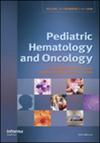Iron deficiency anemia among infants: a retrospective cohort study.
IF 1.2
4区 医学
Q4 HEMATOLOGY
引用次数: 0
Abstract
Postnatal iron deficiency, especially from ages 6 to 24 months, has long-term consequences lasting into adolescence and adulthood. We aimed to characterize iron deficiency anemia among infants from one central Israeli district by demographic and laboratory parameters. A retrospective chart review was performed on all infants from a single district who had undergone a complete blood count as part of a routine survey for iron deficiency anemia during 2010-2021. Data retrieved included hemoglobin levels, mean corpuscular volume, and demographic features: sex, sector (non-ultraorthodox Jew, ultraorthodox Jew, and Arab), socioeconomic status, and type of residence. The study group comprised 101,650 infants, aged 9 to 18 months. Iron deficiency anemia, defined as a hemoglobin level <11 g/dL and mean corpuscular volume <70 fl was observed in 4296 (4.2%) of the study infants. Iron deficiency anemia was more prevalent among Arab and ultraorthodox Jewish infants, than non-ultraorthodox Jewish infants (6.6% vs. 6% vs. 3%, respectively). It was also more prevalent among infants of low socioeconomic status, and relatively common among infants of rural residence. We identified two specific sub-populations at risk of developing iron deficiency anemia: Arab and ultraorthodox Jewish infants. We recommend enhancing the nationwide intervention program for both clinicians and parents, thereby treating iron deficiency anemia promptly to avoid short- and long-term deleterious health consequences.婴儿缺铁性贫血:一项回顾性队列研究。
产后缺铁,尤其是 6 到 24 个月大的婴儿缺铁,其长期后果会持续到青春期和成年期。我们的目的是通过人口统计学和实验室参数来描述以色列中部一个地区婴儿缺铁性贫血的特征。作为缺铁性贫血常规调查的一部分,我们对 2010-2021 年间在一个地区接受全血细胞计数的所有婴儿进行了回顾性病历审查。检索的数据包括血红蛋白水平、平均血球容积和人口统计学特征:性别、部门(非极端正统犹太教、极端正统犹太教和阿拉伯)、社会经济地位和居住地类型。研究对象包括 101,650 名 9 至 18 个月大的婴儿。研究发现,4296 名婴儿(4.2%)患有缺铁性贫血,缺铁性贫血的定义是血红蛋白水平小于 11 g/dL,平均血球容积小于 70 fl。缺铁性贫血在阿拉伯和极端正统犹太教婴儿中的发病率高于非极端正统犹太教婴儿(分别为 6.6% 对 6% 对 3%)。在社会经济地位较低的婴儿中,这种情况也更为普遍,而在居住在农村的婴儿中则相对常见。我们发现了两个容易患缺铁性贫血的特定亚人群:阿拉伯婴儿和极端正统犹太教婴儿。我们建议加强针对临床医生和家长的全国性干预计划,从而及时治疗缺铁性贫血,避免对健康造成短期和长期的有害影响。
本文章由计算机程序翻译,如有差异,请以英文原文为准。
求助全文
约1分钟内获得全文
求助全文
来源期刊
CiteScore
2.60
自引率
5.90%
发文量
71
审稿时长
6-12 weeks
期刊介绍:
PHO: Pediatric Hematology and Oncology covers all aspects of research and patient management within the area of blood disorders and malignant diseases of childhood. Our goal is to make PHO: Pediatric Hematology and Oncology the premier journal for the international community of clinicians and scientists who together aim to define optimal therapeutic strategies for children and young adults with cancer and blood disorders. The journal supports articles that address research in diverse clinical settings, exceptional case studies/series that add novel insights into pathogenesis and/or clinical care, and reviews highlighting discoveries and challenges emerging from consortia and conferences. Clinical studies as well as basic and translational research reports regarding cancer pathogenesis, genetics, molecular diagnostics, pharmacology, stem cells, molecular targeting, cellular and immune therapies and transplantation are of interest. Papers with a focus on supportive care, late effects and on related ethical, legal, psychological, social, cultural, or historical aspects of these fields are also appreciated. Reviews on important developments in the field are welcome. Articles from scientists and clinicians across the international community of Pediatric Hematology and Oncology are considered for publication. The journal is not dependent on or connected with any organization or society. All submissions undergo rigorous peer review prior to publication. Our Editorial Board includes experts in Pediatric Hematology and Oncology representing a wide range of academic and geographic diversity.

 求助内容:
求助内容: 应助结果提醒方式:
应助结果提醒方式:


